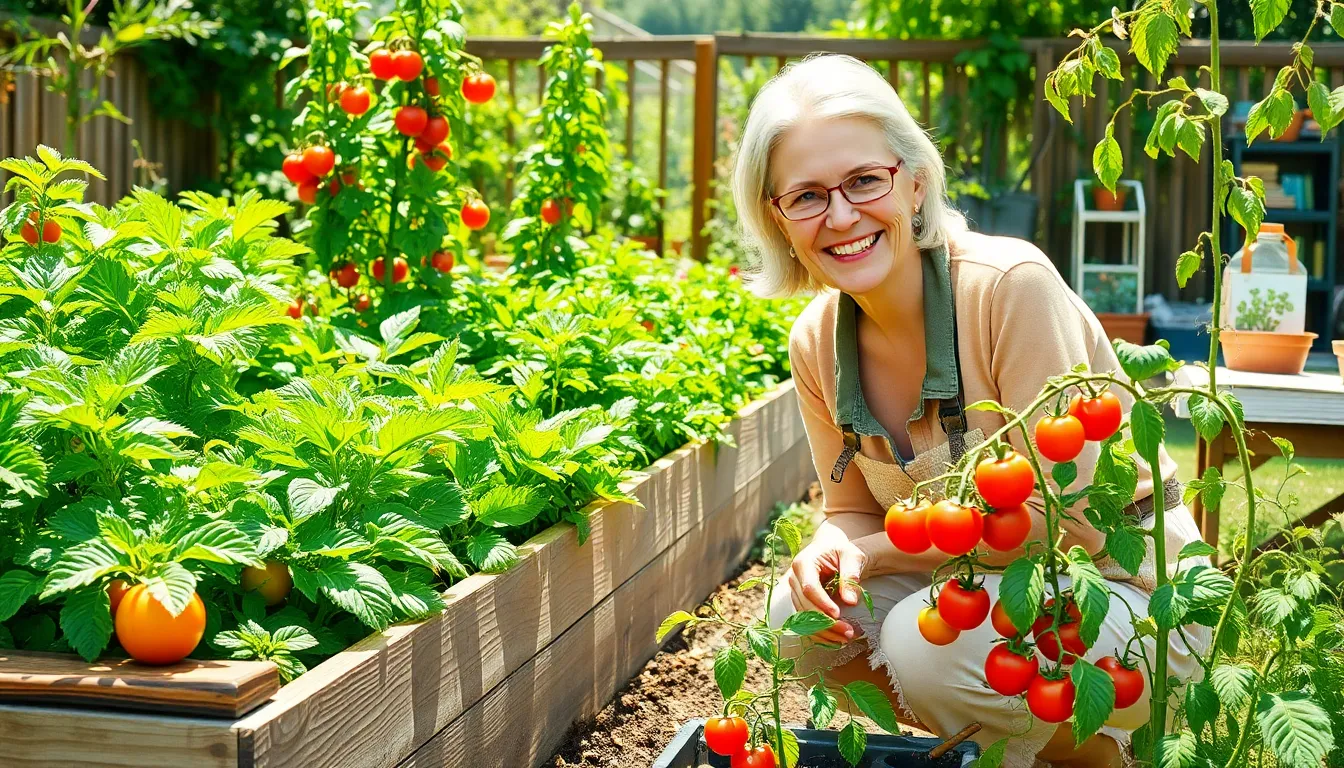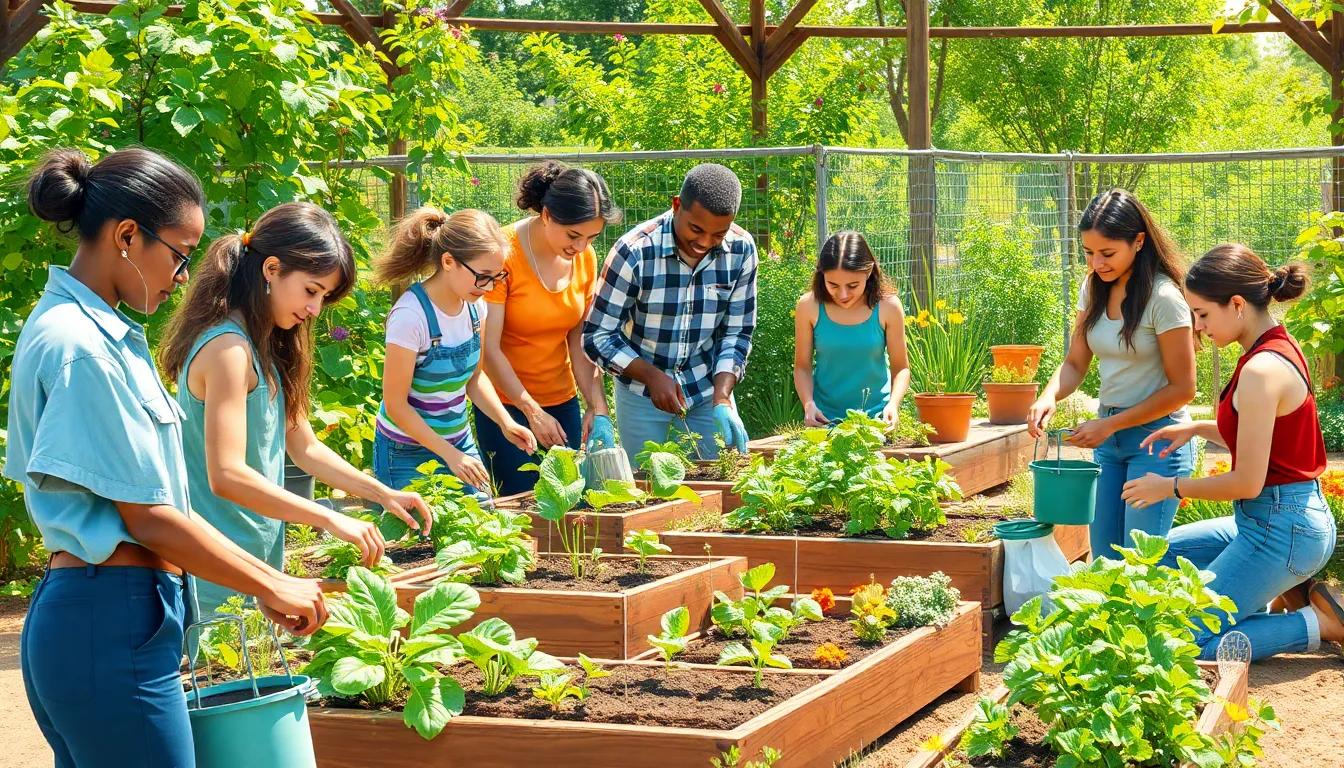Physical Address
304 North Cardinal St.
Dorchester Center, MA 02124

Growing your own vegetables can feel like a superpower, but even superheroes need a trusty sidekick. Enter the world of vegetable gardening books! These gems are packed with tips, tricks, and a sprinkle of humor to help anyone transform a patch of dirt into a thriving garden. Whether you’re battling pesky pests or coaxing stubborn seeds to sprout, there’s a book out there that’ll turn your green thumb dreams into reality.
Gardening books serve as essential guides for anyone aiming to grow their own vegetables. Titles like Square Foot Gardening focus on maximizing space efficiency, making it easier for gardeners with limited areas. Another excellent choice, The Vegetable Gardener’s Bible, provides extensive information about growing a variety of vegetables, empowering readers to cultivate a diverse garden.
Hands-on guides like Rodale’s Vegetable Garden Problem Solver address specific challenges. This book helps gardeners troubleshoot pest issues and plant diseases effectively. With its user-friendly format, it’s suitable for both novice and experienced gardeners alike.
For those interested in organic gardening practices, The Organic Gardener’s Bible delivers valuable insights into maintaining a sustainable garden. It emphasizes organic methods, soil health, and companion planting strategies, enhancing vegetable growth without synthetic fertilizers.
Gardeners seeking aesthetic inspiration can turn to Vegetable Gardening for Dummies. This comprehensive resource combines practical techniques with appealing visuals, making it engaging for readers. It covers everything from soil preparation to harvesting, ensuring a well-rounded gardening experience.
All these titles offer unique perspectives and guidance, catering to different needs and preferences. Selecting the right book aligns with individual gardening goals, whether focusing on space efficiency, troubleshooting, or organic practices. Each book equips readers with knowledge to transform their gardening ambitions into reality.

Gardening books serve as a cornerstone in vegetable gardening, providing valuable insights and expertise. Several essential features enhance their utility for readers.
Comprehensive guides cover a broad range of topics. They delve into soil preparation, plant selection, and seasonal planting schedules. Readers gain in-depth knowledge about pests, diseases, and effective management strategies. Those seeking sustainable practices often appreciate books that emphasize organic gardening techniques alongside conventional methods. Detailed illustrations and charts typically accompany this information, making it easier to follow instructions. Several popular titles serve as excellent comprehensive resources, assisting both novice and experienced gardeners.
Beginner-friendly instructions are crucial for novice gardeners. Clear, step-by-step approaches take the mystery out of growing vegetables. Often, these books include troubleshooting tips for common problems. Simplicity in language and format helps new gardeners absorb concepts quickly. Engaging visuals often break down complex information, catering to visual learners. Additionally, sections that focus on basic tools and starter plants encourage a smooth transition into gardening. Several acclaimed guides prioritize accessibility, ensuring that aspiring gardeners feel confident as they embark on their horticultural journeys.
Numerous vegetable gardening books cater to diverse gardening interests and expertise levels. Here are several recommended titles that can enhance gardening knowledge and techniques.
Square Foot Gardening emphasizes efficient space utilization and increased yield in small areas. Bartholomew introduces a systematic approach to gardening by dividing the garden into square foot sections. This method reduces resource waste while enabling gardeners to grow various vegetables alongside each other.
The Vegetable Gardener’s Bible serves as a comprehensive guide for vegetable gardening enthusiasts. Smith covers a broad spectrum of topics, including plant selection and seasonal care. It includes practical tips and techniques that foster plant health and productivity throughout the gardening year.
Rodale’s Vegetable Garden Problem Solver specializes in troubleshooting common issues in the vegetable garden. Bradley provides insights on identifying pests and diseases, offering practical solutions for effective management. This book is an essential resource for gardeners facing challenges in maintaining healthy plants.
The Organic Gardener’s Bible focuses on sustainable gardening practices and soil health. Stream encourages organic methods that promote biodiversity within the garden ecosystem. By utilizing natural fertilizers and pest control, readers can learn how to cultivate vegetables healthily and responsibly.
Vegetable Gardening for Dummies presents practical information in an approachable format. Nardozzi caters to beginners with simple instructions and visually engaging layouts. This book highlights essential tools and techniques, aiding novice gardeners in developing confidence in growing their own vegetables.
This comprehensive guide serves as a cornerstone for both novice and experienced gardeners. It covers a wide spectrum of topics, including soil preparation, planting, and crop management.
The Vegetable Gardener’s Bible by Edward C. Smith stands as a definitive reference for those diving into vegetable gardening. This book offers a comprehensive overview of various strategies involved in successfully growing vegetables.
Clear guidance on soil preparation takes precedence in this resource. Seasonal planting schedules help gardeners maximize their efforts. Detailed sections on diverse vegetable varieties highlight optimal growing conditions. Illustrations clarify techniques and enhance understanding, making learning easier. Organic gardening tips support sustainable practices ensuring long-term success.
Gardening enthusiasts value the extensive information contained within its pages. Novice and experienced gardeners alike appreciate the structured layout that simplifies complex concepts. Personalized advice caters to different climate zones, ensuring relevance for a wide audience. Engaging visuals enrich the experience, making it suitable for all ages. This book remains a trusted companion for anyone looking to cultivate a thriving vegetable garden.
Choosing the right gardening book involves assessing personal needs and goals. Identify specific gardening interests, such as organic practices, space limitations, or pest management. For instance, those aiming for efficient use of space may prefer Square Foot Gardening, while beginners might gravitate towards Vegetable Gardening for Dummies.
Consider the author’s expertise and writing style. Books written by experienced gardeners or horticulturists, like The Vegetable Gardener’s Bible, often provide in-depth knowledge. Readers seeking troubleshooting advice can opt for Rodale’s Vegetable Garden Problem Solver, which specializes in diagnosing common issues.
Evaluate the book’s coverage of topics that matter most. A comprehensive resource might delve into soil preparation, plant selection, and planting schedules. Visual learners benefit from books featuring illustrations or charts. These elements help clarify complex gardening concepts.
Look for user-friendly instructions catering to beginner gardeners as well. Clear, step-by-step guidance equips novices with the confidence to tackle basic challenges. Engaging visuals often simplify the learning process and enhance retention of information.
Lastly, consider reader reviews and recommendations. Feedback can provide insights into the practicality and effectiveness of the book’s advice. These perspectives help ensure the chosen resource aligns well with individual gardening aspirations and experience levels.
Exploring the world of vegetable gardening can be a rewarding experience with the right resources at hand. Each recommended book offers unique insights tailored to various gardening needs. Whether one seeks to maximize space or troubleshoot common issues, these guides serve as invaluable companions.
By choosing a book that aligns with personal goals and interests, aspiring gardeners can cultivate their skills and confidence. With the knowledge gained from these resources, transforming a simple garden into a thriving vegetable haven becomes an achievable dream. Embracing the journey of gardening not only yields delicious produce but also fosters a deeper connection to nature.